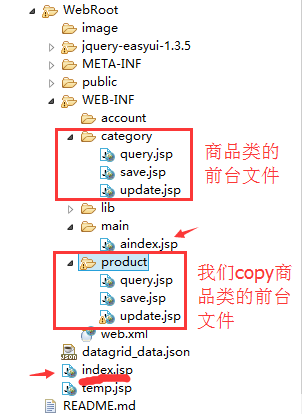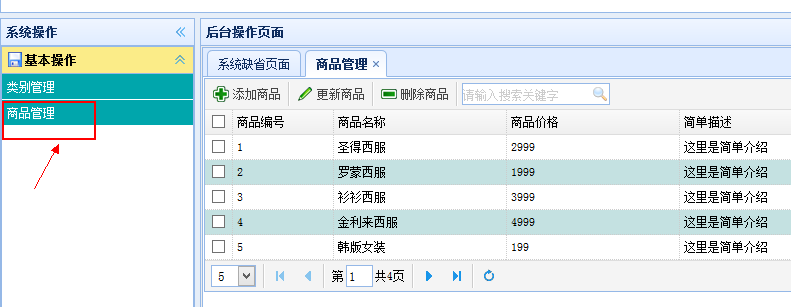前面我們完成了與商品類別相關的業務邏輯,接下來我們開始做具體商品部分。
1. 數據庫建表并映射Model
首先我們在數據庫中新建一張表,然后使用逆向工程將表映射成Model類,表如下:
|
1
2
3
4
5
6
7
8
9
10
11
12
13
14
15
16
17
18
19
20
21
22
23
24
25
26
27
|
/*=============================*/ /* Table: 商品表結構 */ /*=============================*/ create table product ( /* 商品編號,自動增長 */ id int primary key not null auto_increment, /* 商品名稱 */ name varchar(20), /* 商品價格 */ price decimal(8,2), /* 商品圖片 */ pic varchar(200), /* 商品簡單介紹 */ remark longtext, /* 商品詳細介紹 */ xremark longtext, /* 商品生產日期 */ date timestamp default CURRENT_TIMESTAMP, /* 是否為推薦商品,推薦商品才有可能顯示在商城首頁 */ commend bool, /* 是否為有效商品,有效商品才有可能顯示在商城首頁 */ open bool, /* 商品所在的類別編號*/ cid int, constraint cid_FK foreign key(cid) references category(id) ); |
使用逆向工程映射為Model類就不贅述了,前面有提到如何使用逆向工程生成Model。
2. 完成商品類的Service層和Action的架構
2.1 商品類的Service層架構
與前面category一樣,product也得有個service來操作與商品相關的業務邏輯,所以我們得寫一個ProductService和ProductServiceImpl的架構出來,具體如下:
|
1
2
3
4
5
6
7
8
9
10
|
//ProductService接口繼承BaseService<Product> public interface ProductService extends BaseService<Product> { } //ProductServiceImpl實現類繼承BaseServiceImpl<Product>,并實現上面的ProductService接口 @Service("productService") public class ProductServiceImpl extends BaseServiceImpl<Product> implements ProductService { } |
2.2 商品類的Action架構
首先得完善一下BaseAction中關于Service層的注解
|
1
2
3
4
5
6
7
8
9
|
@Controller("baseAction") @Scope("prototype") public class BaseAction<T> extends ActionSupport implements RequestAware,SessionAware,ApplicationAware,ModelDriven<T> { @Resource protected ProductService productService; //其他代碼省略,還是原來的代碼…… } |
然后我們寫一個ProductAction繼承該方法:
|
1
2
3
|
public class ProductAction extends BaseAction<Product> { } |
至此,關于商品的后臺架構就基本搭建好了,接下來就是完善里面的具體功能和業務邏輯了。
3. 完成前臺的基本結構
前臺的基本結構和商品類的一樣,我們看一下已經完成的商品類的前臺都有哪些文件:

我們先根據其商品類的前臺文件,拷貝一份到product文件夾中,然后我們再做相應的修改。先來分析一下流程:首先index.jsp到aindex.jsp顯示左側菜單欄,當點擊類別管理時,進入category/query.jsp頁面右側顯示所有商品類別信息,搜索和刪除功能均在此頁面,不需要彈出新的窗口,添加彈出save.jsp窗口,更新彈出update.jsp窗口。當點擊商品管理的時候,進入product/query.jsp頁面右側顯示所有商品信息,搜索和刪除功能均在此頁面完成,添加和更新分別彈出save.jsp和update.jsp。接下來我們把各個頁面的框架搭建好,然后往相應的部分填東西即可。
首先在aindex.jsp中添加如下代碼:

接下來,我們完成query.jsp的框架:
|
1
2
3
4
5
6
7
8
9
10
11
12
13
14
15
16
17
18
19
20
21
22
23
24
25
26
27
28
29
30
31
32
33
34
35
36
37
38
39
40
41
42
43
44
45
46
47
48
49
50
51
52
53
54
55
56
57
58
59
60
61
62
63
64
65
66
67
68
69
70
71
72
73
74
75
76
77
78
79
80
81
82
83
84
85
86
87
88
89
90
91
92
93
94
95
96
97
98
99
100
101
102
103
104
105
106
107
108
109
110
111
112
113
114
115
116
117
|
<%@ page language="java" import="java.util.*" pageEncoding="UTF-8"%> <!DOCTYPE HTML PUBLIC "-//W3C//DTD HTML 4.01 Transitional//EN"> <html> <head> <%@ include file="/public/head.jspf" %> <style type="text/css"> body { margin: 1px; } .searchbox { margin: -3; } </style> <script type="text/javascript"> $(function(){ $('#dg').datagrid({ //url地址改為請求productAction中的queryJoinCategory方法 url:'product_queryJoinCategory.action', loadMsg:'Loading......', queryParams:{name:''},//這里參數改成name,參數值為空,表示我們要顯示所有商品,后臺是根據商品name屬性查詢的 //width:300, fitColumns:true, striped:true, nowrap:true, singleSelect:false, pagination:true, pageSize:5, pageList:[5,10,15,20], idField:'id',//指定id為標識字段,在刪除,更新的時候有用,如果配置此字段,在翻頁時,換頁不會影響選中的項 //toolbar定義添加、刪除、更新按鈕以及搜索框 toolbar: [{ iconCls: 'icon-add', text:'添加商品', handler: function(){ //添加觸發代碼 } },'-',{ iconCls: 'icon-edit', text:'更新商品', handler: function(){ //添加觸發代碼 } },'-',{ iconCls: 'icon-remove', text:'刪除商品', handler: function(){ //添加觸發代碼 } },'-',{ //查詢按鈕不是LinkButton,它有語法,但是也支持解析HTML標簽 text:"<input id='ss' name='serach' />" }], rowStyler: function(index,row){ console.info("index" + index + "," + row) if(index % 2 == 0) { return 'background-color:#fff;'; } else { return 'background-color:#c4e1e1;'; } }, frozenColumns:[[ {field:'checkbox',checkbox:true}, {field:'id',title:'商品編號',width:100} ]], columns:[[ {field:'name',title:'商品名稱',width:100}, {field:'price',title:'商品價格',width:100}, {field:'remark',title:'簡單描述',width:100}, {field:'xremark',title:'詳細描述',width:100}, {field:'date',title:'上架時間',width:100}, {field:'commend',title:'推薦商品',width:100, formatter: function(value,row,index){ if(value) { return "<input type='checkbox' checked='checked' disabled='true'"; } else { return "<input type='checkbox' disabled='true'"; } } }, {field:'open',title:'有效商品',width:100, formatter: function(value,row,index){ if(value) { return "<input type='checkbox' checked='checked' disabled='true'"; } else { return "<input type='checkbox' disabled='true'"; } } }, {field:'category.type',title:'所屬商品類別',width:200, //category.type是商品類別 formatter: function(value,row,index){ if(row.category != null && row.category.type != null) { return row.category.type; //如果商品類別不為空,返回商品類別 } else { return "此商品暫時未分類"; } } } ]] }); //把普通的文本框轉化為查詢搜索文本框 $('#ss').searchbox({ //觸發查詢事件 searcher:function(value,name){ //value表示輸入的值 //添加觸發代碼 }, prompt:'請輸入搜索關鍵字' }); }); </script> </head> <body> <table id="dg"></table> </body> </html> |
接下來我們完成productAction中的queryJoinCategory方法,在這之前,先要完成service部分,我們都是先從底層慢慢往上開發的:
|
1
2
3
4
5
6
7
8
9
10
11
12
13
14
15
16
17
18
19
20
21
22
23
24
25
26
27
28
29
30
31
32
|
//ProductService接口 public interface ProductService extends BaseService<Product> { //查詢商品信息,級聯類別 public List<Product> queryJoinCategory(String type, int page, int size); //使用商品的名稱查詢 //根據關鍵字查詢總記錄數 public Long getCount(String type); } @SuppressWarnings("unchecked") @Service("productService") public class ProductServiceImpl extends BaseServiceImpl<Product> implements ProductService { @Override public List<Product> queryJoinCategory(String name, int page, int size) { String hql = "from Product p left join fetch p.category where p.name like :name"; return getSession().createQuery(hql) .setString("name", "%" + name + "%") .setFirstResult((page-1) * size) //從第幾個開始顯示 .setMaxResults(size) //顯示幾個 .list(); } @Override public Long getCount(String name) { String hql = "select count(p) from Product p where p.name like :name"; return (Long) getSession().createQuery(hql) .setString("name", "%" + name + "%") .uniqueResult(); //返回一條記錄:總記錄數 } } |
下面可以完成productAction中的queryJoinCategory方法了:
|
1
2
3
4
5
6
7
8
9
10
11
12
13
14
15
16
17
18
19
20
21
22
23
|
@Controller("productAction") @Scope("prototype") public class ProductAction extends BaseAction<Product> { public String queryJoinCategory() { System.out.println("name:" + model.getName()); System.out.println("page:" + page); System.out.println("rows:" + rows); //用來存儲分頁的數據 pageMap = new HashMap<String, Object>(); //根據關鍵字和分頁的參數查詢相應的數據 List<Product> productList = productService.queryJoinCategory(model.getName(), page, rows); pageMap.put("rows", productList); //存儲為JSON格式 //根據關鍵字查詢總記錄數 Long total = productService.getCount(model.getName()); // System.out.println(total); pageMap.put("total", total); //存儲為JSON格式 return "jsonMap"; } } |
接下來在struts.xml中進行配置,跟之前的商品類一樣的流程,到這里可以看出,開發好了一個,下面一個就快了:
|
1
2
3
4
5
6
7
8
9
|
<action name="product_*" class="productAction" method="{1}"> <result name="jsonMap" type="json"> <param name="root">pageMap</param> <param name="excludeProperties"> <!-- rows[0].category.account --> <!-- 把所有account過濾掉,否則會出現懶加載問題,該部分下面截圖 --> </param> </result> </action> |

這樣后臺程序寫好了,然后開啟tomcat,測試一下,當我們點擊左側菜單欄的商品管理時,會彈出右邊如下窗口:

這樣我們就完成了商品管理窗口的框架了。
原文地址:http://blog.csdn.net/eson_15/article/details/51354932
以上就是本文的全部內容,希望對大家的學習有所幫助,也希望大家多多支持服務器之家。













